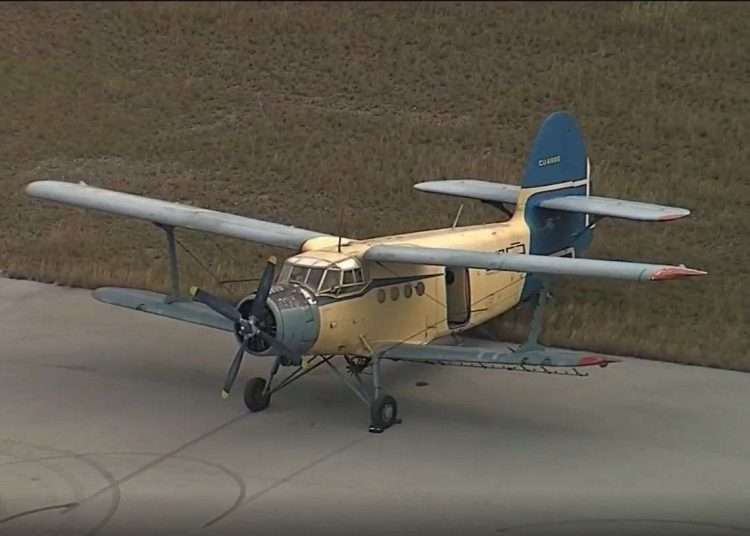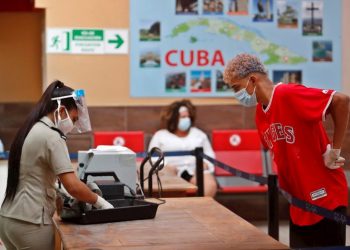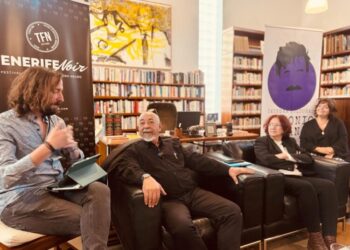The word highjack, used in American English for hijacking of ships or planes, dates from the days of Prohibition, when the mafia made its original accumulation with the liquor trade. The attack voice for launching into trucks loaded with rum and whiskey smuggled in from everywhere was “Hi, Jack,” equivalent to “hands up!”
Beginning in January 1959, fugitives from justice and hijackers of Cuban ships began to arrive in the United States. In April of that year, two DC-3 passenger planes flying between Havana and Nueva Gerona were hijacked by ex-military members of the dictatorship, as part of a series of thefts that included, in that year alone, five national flights and a yacht west of the capital. All the hijackings had in common that they were executed at gunpoint, without raising legal charges against their executors in the United States or returning the ships to Cuba. It would continue like this in the following years.
Like other aspects of the undeclared war on the island, this laissez-faire policy would backfire on its sponsors, and would become a veritable plague for the United States.
On July 23, 1961, the eve of welcoming cosmonaut Yuri Gagarin, who was invited to celebrate July 26 in the Plaza de la Revolución, an Eastern plane bound for Mexico was diverted to Havana by an employee of a cafeteria in Miami. One of the 37 passengers, Arthur J. Shwarz, has recounted that, while waiting for assistance to return to the United States, airport employees offered them dinner and daiquiris, and they even went up to the second floor of the airport to share the welcome to the first man in space
Barely a month after that inaugural episode in the history of the plane hijackings in Cuba, Che Guevara and Richard Goodwin met by chance in Punta del Este, Uruguay. As I have noted before, the secret report of that high JFK adviser describes a rather little-known Che, who offers the United States, four months after the Bay of Pigs, something more than an olive branch, including the thorny issue of Cuban relations with the USSR.
In that conversation, the highest level between the two countries since the conflict unfolded, Che dwells on the topic of the hijacking of ships on both sides. According to Goodwin, Che told him that Cuba “had not been responsible for any hijackings. The one who got hold of the first plane was a young guy who was a good kid, but a bit crazy, and he’s in jail now. They [the Cubans] suspected that the one who seized the last plane was a provocateur (a CIA agent). He fears that if these thefts continue, they will become a very dangerous thing.”
Che then suggested an agreement on the hijackings that would allow them to be stopped. And he ended by proposing “discussing the aircraft issue” as a starting point for “bilateral talks on peaceful coexistence.”
As is well known, the U.S. response was not to take Che at his word, but to apply an action plan known as Mongoose, rather the complete opposite of the olive branch. A few months later, the Soviets would propose to confront that plan, the final phase of which was a U.S. invasion, by installing nuclear missiles on the island.
As is also known, the outcome of the Missile Crisis interrupted air and sea transportation between the United States and Cuba. The only flights that arrived from then on, until the immigration agreement was signed in 1965, were the stolen ones. Since the first hijacking to Havana occurred in 1961, a total of 123 attempts took place in the following six years, 88 of them successful.
Between 1968 and 1971 a veritable global epidemic of hijackings would break out. A study of that four-year period reveals that of the 175 air diversions in the world, 43% were carried out with U.S. aircraft. Most of those that took place in this hemisphere headed for Havana, where a plane arrived every three or four days. Naturally, the reminiscences of most of those hijacked passengers were not as picturesque or peaceful as that of the daiquiri and the reception given to Gagarin.
It was precisely in those years of peak hijackings that Cuba adopted a unilateral initiative to dissuade them. In a public speech on September 19, 1969, Fidel Castro would announce a new law on the treatment of hijackers, according to which they would be prosecuted or extradited to their countries of origin, if the latter had signed an agreement with Cuba.
Although Nixon had been one of the most recalcitrant politicians towards the Cuban Revolution since before 1959, he agreed to explore an understanding with Cuba regarding this sensitive issue of national security. He was reluctant, however, with one aspect of the Cuban proposal: that of returning the hijackers to their countries of origin. According to declassified documents cited by Peter Kornbluh, Nixon did not want to antagonize the Cuban exiles, signing an agreement that forced him to return to Cuba those who arrived on stolen planes and boats.
The following year, however, after new hijackings, and even the payment of a ransom of 2 million by the Southern Airways airline, Fidel Castro again took the initiative: “The Cuban government states that it is not in its interest, nor in no way does it want the territory of Cuba to be used as a refuge for persons responsible for criminal acts…. Nor is the Cuban government interested in any way in promoting hijackings of planes, maritime vessels or illegal entry or exit to or from the United States.”
It is not possible to appreciate the significance of the Cuban proposal or the reaction of the Nixon-Kissinger administration without considering the political context.
Since 1971, initiatives to end the embargo regulations and normalize relations with Cuba have been presented in the United States Congress. Senators like William Fullbright, Ted Kennedy, Jacob Javitts, George McGovern and Claiborne Pell, and representatives like Stephen Solarz and Christopher Whalen were active in the efforts, in some cases as legislative ambassadors to Havana.
So, the Republican administration responded to Cuba’s willingness to negotiate “an agreement regarding hijackings and other serious crimes that could be committed in the future.”
The draft treaty on hijackings presented by Cuba said: “On the basis of equality and strict reciprocity, both governments would punish with ten to thirty years in prison any person who seizes, takes, assumes control of, appropriates, or diverts an airplane or other vessel.” In addition, it proposed persecuting and severely punishing those who used its territory or planned “acts of violence or depredation against aircraft or ships of any kind.”
In the counterproposal for a response submitted to President Nixon, cited by Kornbluh, there are four differences with respect to the Cuban one, essentially the following: not accepting the extradition of the hijackers, but limiting themselves to trying them in the country of arrival; not taking judicial action against previous acts of piracy committed by Cubans residing in the United States; not toughening the penalties for air piracy; not committing to returning seized properties.
Despite these substantial reductions at the edge of the agreement, the two countries ended up signing a document titled “Memorandum of Understanding on the Hijacking of Aircraft and Ships and Other Crimes” on February 15, 1973. It established that all hijackers of airplanes or other vessels would be “regarded as the perpetrators of a crime” and would be either returned to their country of origin to face trial, or tried in the country they landed in. Both agreed to facilitate the return of passengers and crew, as well as ships and planes. Cuba obtained a concession that the United States would punish exiles who planned acts of sabotage against Cuban planes and ships from its territory.
According to the agreement, each party would prosecute, “with a view to imposing a severe punishment…on any person who, within its territory, thereafter, conspired to promote, or promoted, or prepared, or directed, or formed part of an expedition that, from its territory or any other place, carried out acts of violence or depredation against planes or ships of any kind.”
Given that almost nothing in the dynamics of U.S.-Cuban relations can be understood within a strictly bilateral framework, to understand its development in those early 1970s requires looking at the context of Latin America and the Caribbean.
The change in the regional climate towards Cuba operated in favor of a change in U.S. policy towards Latin American that included the island. The select committee that sponsored the Linowitz Report would propose reviewing relations with Cuba, identifying them — along with the Panama Canal problem — as one of the test-cases that would demonstrate a new political will towards the region.
Secret talks took place with the State Department in 1974. Within the framework of the so-called “new dialogue” for Latin America promoted by Henry Kissinger, President Gerald Ford would authorize subsidiaries of U.S. companies to trade with Cuba. In the diplomatic field, progress was made for a change that seemed to lead to a reestablishment
However, the signing of an agreement on ship hijackings in 1973 did not prevent piracy and terrorism from continuing and even worsening. A wave of attacks against embassies and fishing boats reached its climax in 1974. On the other hand, Congress rejected in 1975 the resolution to lift the blockade proposed by Representative Jonathan Bingham. It was evident that the resistance to a change in policy towards Cuba maintained its virulence.
In this contradictory environment, the rapprochement between Cuba and several Latin American and Caribbean countries was perceived as a threat by the anti-Castroists, including the most belligerent sector in the old exile. Their historical ties to the U.S. security apparatus in the 1960s inspired them to maintain “their war against communism throughout the world.” The choice of Barbados, one of the pioneering Caribbean governments in strengthening relations with Cuba, to plan the attack on a Cuban plane in 1976, was not accidental or unrelated to the situation.
The attack on the Cubana flight with 73 people on board, the most colossal terrorist action prior to September 11, was not planned by the CIA, but the FBI did have indications of its preparation by operatives, whose role in the heyday of paramilitary operations against Cuba endowed them with a sense of impunity. The anti-hijacking treaty of 1973 did not survive that attack.
Although Cuba continued to punish those responsible for hijacking ships, the hijackers of Cuban vessels were not punished in the United States, which stimulated these illegal practices, endangering the lives and property of Cuban citizens and foreigners, over the years.
Thirty years later, in the midst of the hostility that characterized bilateral relations under George W. Bush, the U.S. government would warn Cuba that any increase in hijackings to the United States would be perceived as an act against its national security. When a group tried to hijack the Regla boat, in which Cubans and foreign tourists were traveling, in 2003, the Cuban government was under pressure from this threat. The execution of the hijackers had a very negative political impact at the international level. It is just one example of the implications that ship hijackings have had and continue to have for Cuban politics.
To what extent could the Brothers to the Rescue plane incident in 1996 have been prevented if there had been a formal agreement on air and naval security between the United States and Cuba? What retrospective lessons do migratory crises such as Mariel in 1980 and the rafters in 1994 teach regarding the triggering power of hijackings? To what extent do the agreements on the prevention of terrorism, cooperation in the fight against drug trafficking and organized crime signed by Cuba with countries of the Caribbean Basin and Europe offer frameworks applicable to relations with the United States? Is there a Cuban national defense doctrine that takes a position on these topics, including the prevention of piracy and the hijacking of ships?
Investigating these issues and their meaning requires delving into the past.
To be continued…











